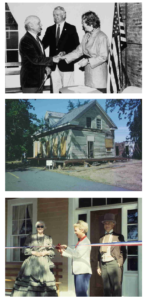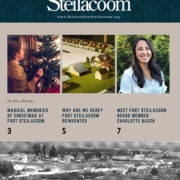Reinventing Fort Steilacoom
Rethinking Lakewood’s oldest institution
By Walter Neary
The following, from our spring 2022 newsletter, comes from two talks Walter gave to Rotary Clubs in Lakewood.
In March of 1856, members of a Washington Territory militia massacred non-combatant Indians around the confluence of the Nisqually and Mashel Rivers. How do we know this? It’s not the official story. The Olympia newspaper, The Pioneer and Democrat, served to write what today we would call press releases for Territorial Governor Isaac Stevens. The paper described the outcome as the result of heroic battles by the territorial volunteers.
We know about this massacre from three primary groups of sources. The first two don’t involve Fort Steilacoom, so let’s summarize them quickly — the oral traditions of the Nisqually Tribe and the memoirs of Ezra Meeker and James Wickersham.
The third way we know of the massacre involves someone who met some of the survivors afterward, namely Augustus Kautz, the U.S. military officer who supervised the construction of the “permanent” buildings at Fort Steilacoom, including the four that form our museum today.
So how do we know about Kautz and the survivors? The mistreatment of Indians did not warrant any sort of special report in those times. Kautz’s recollections come from his memoirs related to his attempted ascent of Mount Rainier. As he passed by a prairie, he wrote:
”
I had visited this spot, and camped nearby with a small detachment of troops,
searching for Indians who had hidden away in these forests, completely
demoralized and nearly starving. A family of two or three men, and quite a
number of women and children, had camped in the fork of the Mishawl and
Nesqually, about two miles from this prairie, and were making fish-traps to catch
salmon.
“When we fell in with them we learned that the Washington Territory
volunteers had been before us, and with their immensely superior force had killed
the most of them without regard to age or sex. Our own little command in that
expedition captured about thirty of these poor, half-starved, ignorant creatures,
and no act of barbarity was perpetrated by us to mar the memory of that success.
”
The Army brought these Natives to a place of relative safety. They brought them to Lakewood. Well, it
wasn’t Lakewood then, of course. It was Fort Steilacoom.
The reason I share this story is that it seems important, and it’s not a story we have often told
around Fort Steilacoom. Part of the reason for this is that Fort Steilacoom has, during its
history, been very focused on the buildings of Fort Steilacoom. But that’s changing and evolving.
Last winter, the board of directors approved an interpretive center plan which has been used to
train docents. You can bet the plan includes references to our four buildings, because we’re proud
of them. But the plan also discusses the people and the place.
Something I think we often fail to share is that Fort Steilacoom has seen six different uses in its history. That’s a lot; more than most areas in Washington, to be sure.
Let’s review those:
- The hunting and gathering grounds of the Nisqually, Puyallup, Steilacoom and other tribes.
- The farm of the Red River settlers from Canada, under the auspices of the Hudson’s Bay Company.
- The farm of Joseph Heath.
- The first U.S. military post in Puget Sound, Fort Steilacoom, 1849-1868.
- The first formal mental health facility in Washington.
- A museum (which is of course what’s there today) as the epicenter of the Fort Steilacoom District, which is on the National Register of Historic Places.
Each one of these uses could generate a huge number of stories, yet our museum’s focus has been primarily on the buildings. And of course, you can absolutely see why. In the 1980s, dozens of people mobilized to save the buildings from collapse. The men and women who saved those
buildings held a grand opening, one by one, as each building was saved.
It was done largely with volunteer labor, which is amazing.
It also tells you a bit about Washington and Washington’s relationship to history. While volunteers saved the Alamo in a similar way, the Alamo is governed today by the Texas Land Office. I am pretty sure the government had a something to do with saving Fort Sutter near where I grew up in Sacramento, California. But perhaps in Washington, we like to do things ourselves.
That must be why, with all the historians in Washington, we allow one of the state’s mental institutions to serve as landlord of some of the most historic ground in Washington.
In cooperation with the fine folk at the hospital, it was private citizens who mustered a small army to rebuild our buildings. We should be just as proud as they were. When our dear longtime secretary Orville Stout retired, he presented us with a hard drive full of images of the museum’s history. There are countless photos of people posing happily next  to buildings that they were preserving for us. One photo is of Steilacoom Mayor Lyle Dunkin with then-Secretary of State Ralph Munro and Jean Gardner, wife of the governor at the time.
to buildings that they were preserving for us. One photo is of Steilacoom Mayor Lyle Dunkin with then-Secretary of State Ralph Munro and Jean Gardner, wife of the governor at the time.
The reconstruction of these buildings was, clearly, a big darn deal.
That said, with four glorious reminders of the pre-Civil War era in our backyard, we still have to remember that there is more to the story of Fort Steilacoom than our buildings. In future reports to the community, we’ll be sure to share more of those stories. Yet we will also not lose sight of those buildings. It was in these buildings that our predecessors walked.
They anchor us to the past.
I must conclude with a reminder that history doesn’t just happen. It has a cost. Sometimes the cost is time. But sometimes the cost is money, such as what we pay for supplies to replace rotting boards. If you had been standing in the rain for 160 winters, you’d need repairs, too.
Everyone at Fort Steilacoom would be grateful if you’d help us support the buildings and the stories in and around them. Memberships start at $15, and you can sign up quickly and easily online at
https://historicfortsteilacoom.org/support.
We like to think that somewhere, Augustus Kautz would be smiling at your help. All this should be remembered and shared.
Author’s note: If you’d like to read more about the Mashel Massacre, Historylink has a post at https://www.historylink.org/File/8941. This author thinks they are a bit hard on Meeker and Wickersham but the reader can make up their own mind.



